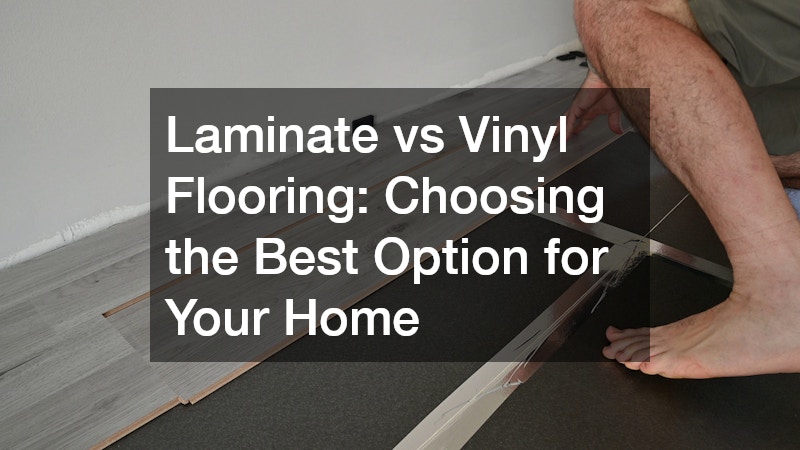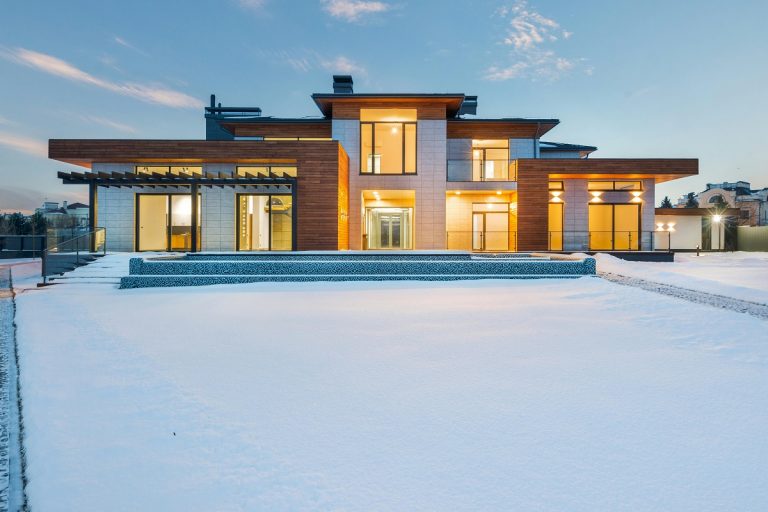

When it comes to upgrading your floors, laminate and vinyl are two of the most popular choices for homeowners. Both offer a wide range of styles, durability, and affordability — but which is better for your home?
In this guide, we’ll compare laminate vs vinyl flooring in detail, covering their differences, pros and cons, installation, cost, and maintenance. By the end, you’ll have a clear idea of which flooring type fits your needs and budget.
What Is Laminate Flooring?
Laminate flooring is a multi-layer synthetic product designed to look like real wood, stone, or tile. It’s made with a high-density fiberboard (HDF) core, topped with a photographic image layer, and finished with a clear protective coating.
Key Features of Laminate Flooring:
- Made from wood byproducts (HDF or MDF core)
- Realistic wood or stone designs
- Hard and durable surface
- Installed as a floating floor with a click-lock system
Laminate gained popularity because it’s more affordable than hardwood yet offers a similar look.
What Is Vinyl Flooring?
Vinyl flooring is made entirely from synthetic materials, primarily PVC (polyvinyl chloride). It’s available in various forms, including luxury vinyl plank (LVP), luxury vinyl tile (LVT), and sheet vinyl.
Key Features of Vinyl Flooring:
- 100% waterproof (ideal for kitchens, bathrooms, and basements)
- Flexible and resilient surface
- Available in planks, tiles, or large rolls
- Can mimic wood, tile, or stone with high realism
Vinyl has improved drastically in recent years, offering more realistic textures and patterns than older sheet vinyl styles.
Laminate vs Vinyl: Key Differences
While both laminate and vinyl can look similar at first glance, their core materials, durability, and resistance to moisture make them quite different.
| Feature | Laminate Flooring | Vinyl Flooring |
| Core Material | HDF (wood-based) | PVC (plastic-based) |
| Water Resistance | Water-resistant (not fully waterproof) | 100% waterproof |
| Durability | Scratch-resistant | Scratch & water-resistant |
| Comfort | Feels harder underfoot | Softer, warmer feel |
| Installation | Floating click-lock | Floating, glue-down, or loose lay |
| Price Range | $1.50 – $5 per sq. ft. | $2 – $7 per sq. ft. |
Appearance and Style Options
Both laminate and vinyl offer a wide variety of colors, patterns, and textures.
Laminate
- Often provides a more realistic wood texture due to its thicker wear layer.
- Available in matte, textured, and glossy finishes.
- Best for living rooms, bedrooms, and dining areas.
Vinyl
- Offers excellent wood and stone visuals with embossing for texture.
- Can include beveled edges for a more authentic plank look.
- Works well in bathrooms, laundry rooms, and basements due to waterproofing.
Tip: If you’re aiming for a high-end hardwood look without the cost, high-quality laminate or LVP can both deliver stunning results.
Durability and Lifespan
Laminate
Laminate is highly resistant to scratches and dents, making it a good choice for households with pets and kids. However, because it’s made from wood fibers, it can swell and warp if exposed to standing water.
Average lifespan: 15–25 years with proper care.
Vinyl
Vinyl is resistant to water, scratches, and stains. This makes it ideal for high-traffic and moisture-prone areas. Its flexibility allows it to handle small subfloor imperfections better than laminate.
Average lifespan: 20–30 years, especially for thicker LVP with a strong wear layer.
Water Resistance
One of the biggest differences between laminate vs vinyl flooring is how they handle water.
- Laminate: Water-resistant options exist, but most laminate should be cleaned quickly after spills to avoid swelling.
- Vinyl: 100% waterproof, making it a safer choice for kitchens, bathrooms, laundry rooms, and basements.
If you live in a humid climate or want the same flooring throughout your home, vinyl offers better peace of mind against moisture damage.
Comfort and Noise
- Laminate: Feels harder underfoot and can be noisy without underlayment. Adding a foam or cork underlayment can reduce noise and add comfort.
- Vinyl: Softer and warmer underfoot, with better sound absorption. Thicker vinyl planks feel more cushioned.
Installation Process
Both laminate and vinyl can be DIY-friendly options, but their installation methods and requirements differ in important ways. Understanding these differences will help you choose the right material for your project.
Laminate Installation
- Usually installed as a floating floor with click-lock planks, which snap together without glue or nails.
- Requires an underlayment for cushioning, sound reduction, and moisture protection.
- Works well over most existing floors, such as tile or vinyl, as long as the subfloor is clean and level.
- Cutting laminate planks often requires a saw, so some basic tools and safety gear are necessary.
- Expansion gaps around the perimeter are essential to allow for natural movement and prevent buckling.
Vinyl Installation
- Can be floating click-lock, glue-down, or loose lay, depending on the product type.
- No underlayment is required for waterproof vinyl, though adding one can improve comfort and insulation.
- More forgiving over uneven subfloors because of its flexibility and thinner profile.
- Can be cut with a utility knife, making it easier for beginners to work with.
- Works well in irregular-shaped rooms where trimming around obstacles is necessary.
If you’re tackling a weekend DIY project, laminate offers a straightforward approach for open, level spaces, while vinyl provides more versatility for tricky layouts and moisture-prone areas.
Cost Comparison
Flooring cost depends on quality, brand, and installation method.
Laminate:
- Material: $1.50 – $5 per sq. ft.
- Installation: $2 – $4 per sq. ft.
- Total installed cost: $3.50 – $9 per sq. ft.
Vinyl:
- Material: $2 – $7 per sq. ft.
- Installation: $1.50 – $3 per sq. ft. (floating)
- Total installed cost: $3.50 – $10 per sq. ft.
While laminate often starts cheaper, high-end vinyl can be more budget-friendly than premium laminate.
Maintenance and Cleaning
Both laminate and vinyl flooring are generally low-maintenance, but they require slightly different care routines to keep them looking their best. Understanding these differences can help extend the life of your floors and maintain their appearance.
Laminate Cleaning:
- Sweep or vacuum regularly – Remove dust, dirt, and debris to prevent scratches.
- Use a damp mop — avoid excess water – Too much moisture can cause laminate to warp or swell.
- Clean spills immediately – Prevent liquid from seeping into seams and damaging the floor.
- Use laminate-safe cleaners – Harsh chemicals can dull the surface or strip protective coatings.
Laminate floors benefit from gentle, moisture-controlled cleaning. Since they are not waterproof, quick attention to spills and regular dry cleaning methods will help them last longer without warping or damage.
Vinyl Cleaning:
- Sweep, vacuum, or mop as needed – Vinyl can handle more frequent cleaning without damage.
- Wet mopping is safe – Most vinyl types can handle excess water during cleaning.
- Compatible with most cleaning solutions – From mild soaps to stronger cleaners, vinyl tolerates a wider range of products.
- Highly resistant to stains – Great for high-traffic or messy areas like kitchens and entryways.
Vinyl flooring is easier to maintain in busy households. Its water resistance makes it more forgiving of spills, and its durable surface holds up well against both stains and frequent cleaning.
Eco-Friendliness
If sustainability matters to you, laminate often contains recycled wood materials and can be more eco-friendly. Vinyl, while durable, is made from plastic and can be harder to recycle.
Best Rooms for Each Flooring Type
Laminate:
- Living rooms
- Bedrooms
- Dining rooms
- Hallways
Vinyl:
- Bathrooms
- Kitchens
- Laundry rooms
- Basements
Pros and Cons Summary
Laminate Pros
- Realistic wood look
- Scratch-resistant
- Affordable
- Easy DIY installation
Laminate Cons
- Not waterproof
- Feels harder underfoot
- Can swell if wet
Vinyl Pros
- 100% waterproof
- Softer and quieter
- Works in any room
- Durable and low-maintenance
Vinyl Cons
- Can fade in direct sunlight
- May dent under heavy furniture
- Less eco-friendly
How to Choose Between Laminate and Vinyl Flooring
When deciding between laminate vs vinyl, consider these factors:
Moisture levels: Vinyl is the clear winner for moisture resistance. It can handle spills, humidity, and even standing water, making it ideal for bathrooms, kitchens, and basements. Laminate, while durable, can swell or warp when exposed to excessive moisture.
Budget: Laminate is often slightly cheaper upfront, making it attractive for cost-conscious projects. However, vinyl’s waterproof properties and lower long-term maintenance needs can make it a more cost-effective choice over time, especially in moisture-prone areas.
Style preference: Both flooring types come in a wide variety of colours, patterns, and designs. Laminate often has a slight edge in texture realism, closely mimicking hardwood with more defined ridges and grain patterns. Vinyl, however, has improved greatly in recent years, offering equally stunning visuals with the bonus of being softer underfoot.
Room usage: Laminate is best suited for dry, low-moisture spaces like living rooms, dining areas, and bedrooms. Vinyl’s durability and water resistance make it versatile enough for every room in the house, including high-traffic and wet areas.
Final Verdict
Both laminate and vinyl flooring have their strengths. If you want the most realistic wood look for dry areas at a lower cost, go with laminate. If you need a waterproof, versatile floor that works in any room, vinyl is your best choice.
Either way, both options offer beauty, durability, and easy maintenance — making them excellent picks for a stylish home upgrade.








